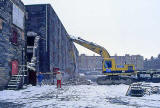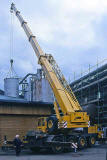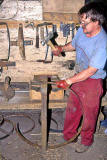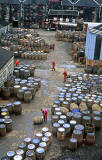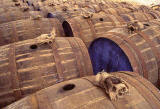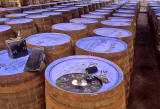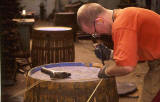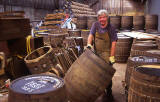|
North British Distillery Background and History |
|
1885 Company Established In 1885, more than half of Scotland's whisky was being produced in illicit stills and smuggled to the customers. Many of these small stills went on to become the well known distilleries in the 1900s. It was in 1885 that The North British Distillery Company was founded in Edinburgh. Andrew Usher was appointed as the company's Chairman. Site Acquired It was agreed to acquire a ten-acre field in the meadows to the west of Gorgie. The site lay close to several railway lines at Roseburn. There were then no houses in the area. The site lay about half a mile to the north of the Union Canal. The company negotiated rights, in 1886, to draw water from the canal for a payment of £250 pa in perpetuity. After 70 years, facing a threat that the canal might close, the company agreed to voluntarily increase its annual payment. Distillery Opens A grain whisky distillery was built on the site and came into use in 1887. It was able to produce 25,000 gallons per week. The nearby Caledonian Distillery, the largest in Britain, could produce 40,000 gallons per week. The North British Distillery sold its whisky only to wholesale customers, charging them 1s 6d (7.5 pence) per gallon. |
|
Around 1900 William Sanderson Under its first Managing Director, William Sanderson, who held the post until his death in 1908, the company expanded. A 'pug' locomotive was acquired in 1897. New bonded warehouses were built, and more land was acquired in 1900. Andrew Usher The company's first Chairman, Andrew Usher retired in 1898 and died a few months later. He left a bequest of £100,000 to build the Usher Hall, a concert hall in Lothian Road, Edinburgh. Malt and Grain Distilleries The early 1900s saw a slump in whisky sales and fierce competition between the malt distillers and grain distillers, the former claiming that only their product could truly be described as whisky. |
|
1910 to 1930 World War I During the War whisky production almost entirely ceased. A factory was built to produce acetone for the government, but it was never used. Full production of whisky began again in 1920, but the company faced a variable and falling demand for its product, increasing duties, fluctuating prices for grain and high prices for coal due to the coal strike. Expansion Production picked up in the 1930s, reaching 70,000 gallons a week in 1937. |
|
1940 to 1989 World War II The outbreak of war in 1939 brought about a lack of raw materials. Production ceased for the first six months of 1940. Almost no whisky was produced during the war, and it was not until the late 1940s that full production was reached again. Transport The company's first motor lorry was acquired in 1947, having previously relied on a cart and white-faced chestnut horse. By 1967, the company had a fleet of six Commer lorries. Maltings Its malting equipment was upgraded in 1948, the old pneumatic drums being replaced by 'Saladin' boxes - large reinforced concrete receptacles positioned under the 'steeps' for soaking the grain. A new maltings came into use at Slateford Road after the company had acquired the former premises of Scottish Brewers in the early-1960s. By-Products By the 1960s, the company was producing most of its own yeast, and it was using most of its spent material to produce products such as 'Dark Grains' cattle-cake. Warehouses Up to 1953, the company had just one warehouse. It was at Westfield, across the railway from the Wheatfield Road distillery. Two more were built within the next couple of years. By 1961, the company had acquired more land - the former Corporation tramcar depot at Westfield and former premises of Scottish Brewers at Slateford Road beside Gorgie Station By 1964 had built four more warehouses, giving it capacity to store a total of 21,000,000 gallons of spirit. By 1975, it had 5 warehouses at Wheatfield Road, 6 at Westfield, 4 at Slateford Road and 9 on their 70-acre site at Muirhall, beyond West Calder, in West Lothian. Part of the Muirhall site had been bought from the then defunct mineral-oil firm founded by James Young - 'Paraffin' Young. Distillery In 1970, the company was still charging its wholesale customers only 6s 6d (32.5p) per gallon for its whisky. and demand for the product was high. The distillery was enlarged between 1976 and 1979. New mash tuns, malt mills and washbacks were installed and laboratory facilities were improved. Workforce In 1930, the workforce was about 100. Most lived within walking distance of their work and many were members of the company's bowling club. The company built its own bowling green close to the General Manager's house near the main gate to the distillery. By the 1960s, the workforce had increased to almost 400. |
|
1990 onwards Wheatfield Road - Yard During the 1990, further modernisation took place on the North British Distilleries' site at Wheatfield Road. Some of the old warehouses ('sheds') had been declared unsafe and were being demolished. New tanks had recently been installed beside the distillery. Another was being lowered into position during one of my visits.. Wheatfield Road - Cooperage The old cooperage in the yard at Wheatfield Road closed. Muirhall - Cooperage However, when I visited the company's cooperage at Muirhall, beyond West Calder, I found that there were 11 coopers employed there, 9 working on the day that I took this photo: I learnt that the barrels being worked on were US oak that had previously been used for bourbon. They can only be used once for bourbon and are set on fire before filled with bourbon. A hogshead holds 250 litres A butt holds 450 to 500 litres. The bungs were traditionally be made of oak, but are now there is a move to poplar. The seal is hessian: The numbers on the end of barrels were being applied with roller and stencil. Some companies now spray the numbers on. Soon, bar codes will be used instead. Muirhall - Filling the Barrels When I visited the cooperage at Muirhall in 1995 , I learnt that the North British Distillery was then producing 1,000,000 litres of whisky per week and that 700 barrels per day were being filled at Muirhouse, using two large holding tanks, each with a capacity of 10 road tankers. Slateford Road - Maltings At the maltings in Slateford Road, I saw maize being delivered by lorry from Leith. I saw 32 fermentation vessels, 26 holding 205,000 litres each and 6 holding 410,000 litres each. |
|
Acknowledgements 1885-1989: These details have been taken from a book published by NB Distillery that I was given during my visits to photograph the distillery during the 1990s. The title of the book: "The North British Distillery Company Ltd Centenary 1885-1985 (Leslie Gardner)" 1990 onwards: These details are taken from what I was told and what I saw during my visits to photograph the distillery during the 1990s. |
|
Photos |
||
|
Recollections |
||
